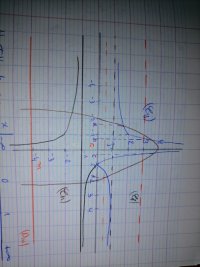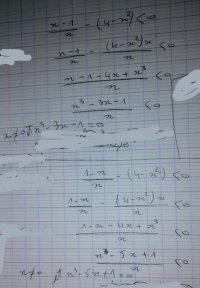Your description of what you have learned is very vague. Have you learned about solving polynomial or rational inequalities?
I hoped to see
some attempt at solving the inequality algebraically! The graph, which is good, helps to see what to expect, but not to give the actual solution (unless the values turned out to be simple points you'd graphed).
The inequality, after replacing functions with their expressions, turns out to be
|(1 - x)/x| - (4 - x^2) < 0
To handle an absolute value, I would start by making cases: Find when (1 - x)/x is positive and negative, and in the latter case, the absolute value will equal -(1 - x)/x. (The graph sketch is helpful here.)
This gives you two different rational inequalities to solve within different regions. The standard way to solve these is to combine them into a single fraction (using a common denominator) and factor to find when the numerator and denominator are zero. Does any of that sound familiar?
So, what can you do with the first case"
(1 - x)/x - (4 - x^2) < 0




